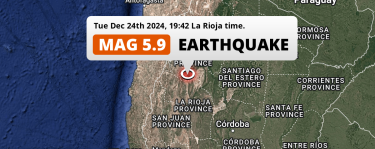Latest earthquakes near Argentina today
Complete overview of the latest earthquakes near the country Argentina, updated every minute. Did you feel an earthquake today in Argentina? If an earthquake is happening right now near Argentina, it will show up within minutes.
Recent Argentina Earthquake News
These are the latest articles published related to earthquakes occurring near Argentina. Check our Earthquake News section for a complete overview of articles written on earthquakes near Argentina and elsewhere.
Argentina Earthquake Statistics
Average
A total of 4249 earthquakes with a magnitude of four or above have struck within 300 km (186 mi) of Argentina in the past 10 years. This comes down to a yearly average of 424 earthquakes per year, or 35 per month. On average an earthquake will hit near Argentina roughly every 0 days.
A relatively large number of earthquakes occurred near Argentina in 2015. A total of 585 earthquakes (mag 4+) were detected within 300 km of Argentina that year. The strongest had a 7 magnitude.

Magnitude Distribution
The table below visualizes the distribution of all earthquakes that occurred within 300km of Argentina in the past 10 years. No earthquakes with a magnitude of 8 or above have occurred near Argentina during this time. Usually, higher magnitudes are less common than lower magnitudes. Small earthquakes with a magnitude below 4 on the Richter scale have been omitted from this overview.
| Magnitude | Earthquakes | Percentage |
|---|---|---|
| Mag. 4 | 4002 | 94.19% |
| Mag. 5 | 213 | 5.01% |
| Mag. 6 | 31 | 0.73% |
| Mag. 7 | 3 | 0.07% |
| Mag. 8 | 0 | 0.0% |
| Mag. 9 | 0 | 0.0% |
| Mag. 10 | 0 | 0.0% |
Strongest earthquakes near Argentina
The strongest recent earthquake of the past 10 years near Argentina occurred on Dec 25, 2016 11:22 local time (America/Argentina/Catamarca timezone). It had a magnitude of 7.6 and struck 220 kilometers (137 mi) west-southwest of Esquel, at a depth of 38 km. Discover more strong earthquakes near Argentina in the list below.
A longer time ago, a MAG-8.2 earthquake struck on Dec 9, 1950 18:38, 269 kilometers (167 mi) west-southwest of Salta. It is the strongest earthquake near Argentina in the past 125 years (Our data goes back to January 1st, 1900).
In the table below you will find the strongest earthquakes that occurred near Argentina in the past 10 years. You can use the tabs to find the heaviest historic earthquakes since the year 1900 or within a specific year or distance from Argentina.
Earthquakes by region of Argentina
Click the links below for earthquake reports for regions in Argentina.
- Buenos Aires
- Buenos Aires F.D. (Buenos Aires C.F.)
- Catamarca
- Chaco
- Chubut
- Cordoba (Córdoba)
- Corrientes
- Entre Rios (Entre Ríos)
- Formosa
- Jujuy
- La Pampa
- La Rioja
- Mendoza
- Neuquen (Neuquén)
- Rio Negro (Río Negro)
- Salta
- San Juan
- San Luis
- Santa Cruz
- Santa Fe
- Santiago del Estero
- Tierra del Fuego
- Tucuman (Tucumán)
Frequently Asked Questions
These questions are commonly asked in relation to earthquakes occurring near Argentina.
When was the last earthquake in Argentina?
A 3.2 magnitude earthquake hit near Argentina on the afternoon of February 1, 2025 at 15:12 local time (America/Argentina/Mendoza). The center of this earthquake was located 260km west of San Rafael at a depth of 96km under land. Check the list on our website for any earthquakes occurring near Argentina in the past hours.
What was the strongest earthquake near Argentina?
A 8.2 magnitude earthquake hit near Argentina on the evening of December 9, 1950 at 18:38 local time (America/Argentina/Salta). The center of this earthquake was located 269km west-northwest of Salta at a depth of 114km under land. This is the strongest earthquake that occurred near Argentina since the year 1900.
How often do earthquakes occur near Argentina?
In the past 10 years, 4249 earthquakes with a magnitude of four or higher occurred within a 300 kilometer range from Argentina. This averages to 425 earthquakes yearly, or one earthquake every 1 days.

 Dec 24, 2024 07:42PM
On Tuesday Evening an Unusually powerful M5.9 Earthquake struck 143km from La Rioja in Argentina.
Dec 24, 2024 07:42PM
On Tuesday Evening an Unusually powerful M5.9 Earthquake struck 143km from La Rioja in Argentina.
 Dec 13, 2024 08:38PM
On Friday Evening a Strong M6.4 Earthquake struck near Curicó in Chile.
Dec 13, 2024 08:38PM
On Friday Evening a Strong M6.4 Earthquake struck near Curicó in Chile.
